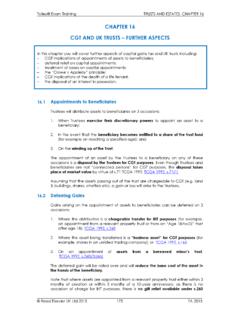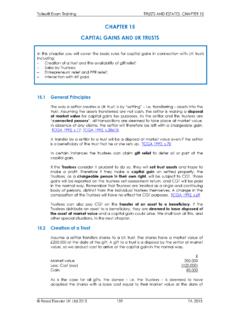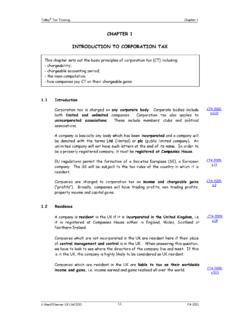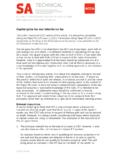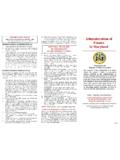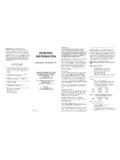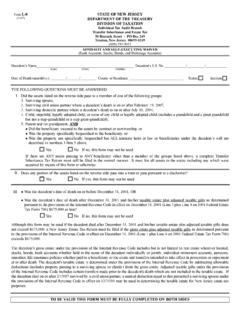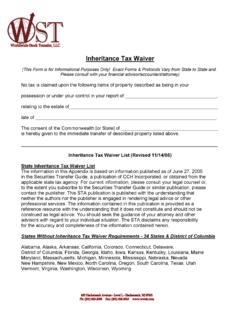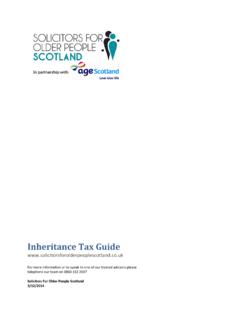Transcription of CHAPTER 7 INHERITANCE TAX – PRINCIPAL …
1 Tolley Exam TrainingTRUSTS AND ESTATES CHAPTER 7 Reed Elsevier UK Ltd 201569FA 2015 CHAPTER 7 INHERITANCE TAX PRINCIPAL CHARGESIn this CHAPTER you will cover the rules for calculating PRINCIPAL charges on relevant property trusts including: Calculating the effective rate to use; Exits from trusts after the first PRINCIPAL charge; Future PRINCIPAL PRINCIPAL ChargeA PRINCIPAL charge will be levied on each 10-year anniversary following the commencement of the trust. IHTA 1984, PRINCIPAL charge is a percentage of the value of the trust at the 10 year anniversary, ie:Value of relevant property @ 10-year anniversary actual rate of tax As was the case for exit charges, we shall use a procedure to determine the actual rate of tax. IHTA 1984, trustees are deemed to have made a transfer of value equal to the value of the trust at the 10-year this is a chargeable transfer, the value of relevant property at the date of the PRINCIPAL charge can be reduced by any APR or BPR.
2 This means that if the assets of the trust consist wholly of shares in an unquoted trading company qualifying for 100% business property relief, the PRINCIPAL charge will be is the case for exit charges, the actual rate of tax is arrived at by determining the effective rate of tax, and multiplying this by 30%. IHTA 1984, (1)For exit charges, we then multiply this rate by n/40 when n is the number of quarters that have elapsed between the date of creation and the date of the exit looking at PRINCIPAL charges, the number of quarters between the date of commencement and the first PRINCIPAL charge will be exactly 40. As this fraction gives a figure of one, it can be Effective RateThe first thing we must therefore do to calculate the PRINCIPAL charge, is to arrive at the effective effective rate is a notional rate of IHT which would be charged on a notional transfer.
3 To calculate the effective rate, we use the IHT history of the settlor of the trust. To calculate the effective rate, we pretend that the settlor had made a transfer of value equal to the relevant property in the trust at the 10 year anniversary. This notional transfer is increased by adding on the initial value of a Tolley Exam TrainingTRUSTS AND ESTATES CHAPTER 7 Reed Elsevier UK Ltd 201570FA 2015related trust. Remember that a related trust was a trust set up on the same day by the same settlor. IHTA 1984, (3); IHTA 1984, (4)To calculate the notional tax, we use the IHT nil band at the date of the 10 year charge. This nil band is reduced by the settlor's cumulative chargeable transfers. Here we look back at the settlor's transfers in the 7 years prior to the creation of the trust.
4 Note we do not simply look at transfers made in the 7 years prior to the 10 year charge. IHTA 1984, (5)(a)The nil band is further reduced by any distributions made by the Trustees in the 10 years preceding the PRINCIPAL charge. Therefore any exits made in the first 10 years of the trust will affect the first PRINCIPAL charge. Once we have the nil band remaining, we can calculate the notional tax and thereafter calculate the effective rate. IHTA 1984, (5)(b) PRINCIPAL charge proforma: Current value of relevant property at 10 year anniversary (net of APR/BPR)AInitial value of related trustBCNil band at date of PRINCIPAL chargeNBLess: Settlor's chargeable transfers in 7 years before creation of trust(CTs)Less: Distributions by Trustees in last 10 years(D)Nil band remaining(NBR)ENotional tax at 20%NTEffective rate: NT/C 100ER (%)Actual rate: ER% 30%AR (%) PRINCIPAL charge: Current value AR (%) PC Illustration 1On 7 August 2005, Frederick created a discretionary trust with 600,000 in cash.
5 Frederick paid the IHT on the creation of the trust. His chargeable transfers in the 7 years prior to setting up the trust were 120, 15 December 2009, the trustees distributed 85,000 to a beneficiary. This gave rise to an IHT exit charge. The beneficiary paid the tax on the 7 August 2015 10 years after the commencement of the trust the relevant property within the trust was worth 900,000. Calculate the PRINCIPAL charge arising in August Exam TrainingTRUSTS AND ESTATES CHAPTER 7 Reed Elsevier UK Ltd 201571FA 2015 Current value of relevant property900,000 Initial value of related trustNil900,000 Nil band at August 2015325,000 Less: CTs in 7 years pre creation of trust(120,000)Less: Distributions in last 10 years(85,000)Nil band remaining(120,000)Chargeable780,000 Notional tax at 20%156,000 Effective rate: 156,000/900,000 Actual rate: 30% 40/40 = charge: 900,000 =46,800 In no circumstances can the actual rate ever exceed 6%.
6 This tax is payable by the trustees on 28 February 2016. (6 months from the end of the month of the transfer).Even though this tax is payable by the Trustees, no grossing up is necessary as the only asset leaving the trust is the cash being used to pay the you will see from the above illustration, the calculation of tax on a PRINCIPAL charge is very similar to the calculation of tax on an exit both instances we calculate an effective rate, and multiply this by 30% to get an actual rate. We then use that actual rate to calculate the IHT. However, when calculating the PRINCIPAL charge, the n/40 fraction is not a consideration as 40 complete quarters will have PointsThe current value of relevant property at the 10-year date is net of any APR or or BPR will be given provided that the Trustees have relevant business or agricultural property, and have satisfied minimum ownership requirements.
7 Therefore a PRINCIPAL charge cannot be avoided by the Trustees simply swapping assets for relevant business property immediately prior to the 10-year charge as the 2 year ownership period would not have been satisfied. IHTA 1984, ; IHTA 1984, exit charges made by the Trustees in the 10 years preceding the PRINCIPAL charge, will affect the actual rate of tax. IHTA 1984, (5)(b)The amount of property leaving the trust is not necessarily the same as the value of the property being transferred to the beneficiaries. We use the loss to trust principle to calculate the reduction in the value of relevant addition, if IHT on the exit was paid by the Trustees, this tax must be added to the distribution to find the loss to trust . For example, if Trustees distributed 100,000 to Tolley Exam TrainingTRUSTS AND ESTATES CHAPTER 7 Reed Elsevier UK Ltd 201572FA 2015a beneficiary and the trustees paid tax of 5,000 on the exit, the loss to trust in the previous 10 years would have been 105, , the notional transfer at the 10-year date is the current value of relevant property plus the initial value of property in a related trust.
8 In an examination question, the examiner might give you a current value of a related trust. This is a red herring and will not affect the IHT calculations. IHTA 1984, (4)(c) Charge After a PRINCIPAL ChargeSo far we have looked at how we calculate tax on an exit within the first 10 years of the trust, and how we work out the PRINCIPAL charge at the 10-year anniversary. The final thing to look at is how we calculate tax on exits from the trust after the first PRINCIPAL charge. IHTA 1984, an exit take place after the first PRINCIPAL charge ie property is distributed by the trustees more than 10 years after creation - we do not use the original exit charge procedure to calculate the tax. The exit charge procedure used in the previous CHAPTER is only relevant for exits in the first 10 calculate tax on an exit after the first or later PRINCIPAL charges, we again calculate an effective rate, then turn that into an actual rate, and then use that actual rate to calculate the IHT.
9 IHTA 1984, (1)However, in this instance, the effective rate we use is that which is in force at the date of the preceding PRINCIPAL charge. This effective rate must be adjusted if the IHT nil band has changed between the date of the PRINCIPAL charge and the date of the arrived at the effective rate, we then multiply that by 30% to arrive at the actual rate. As this is an exit charge, the rate must then be multiplied by n/40 where n is the number of quarters between the date of the PRINCIPAL charge and the date of the Rate = Effective Rate 30% n/40 This actual rate is then multiplied by the property leaving the trust to find the exit charge. Illustration 2 Returning to the example of Frederick. Frederick set up a discretionary trust in August 2005.
10 A distribution was made by the Trustees in December 2009. In the previous example, we calculated the INHERITANCE tax payable by the Trustees on the PRINCIPAL charge on 7 August 21 December 2016, the Trustees made a distribution of 120,000 to a beneficiary such that an exit charge will arise. Calculate the IHT on this Exam TrainingTRUSTS AND ESTATES CHAPTER 7 Reed Elsevier UK Ltd 201573FA 2015 The distribution takes place in the tax year 2016/17. The nil band for 2016/17 will be 325, effective rate: Value at ,000 Nil band at exit 2016/17325,000 Less: B/fwd total(120,000)Less: Exit (85,000)Nil band remaining(120,000)780,000 Notional tax at 20%156,000 Effective rate: 156,000/900,000 rate: 30% 5 charge: 120,000 Tax on the exit will either be paid by the Trustees or the beneficiary.


